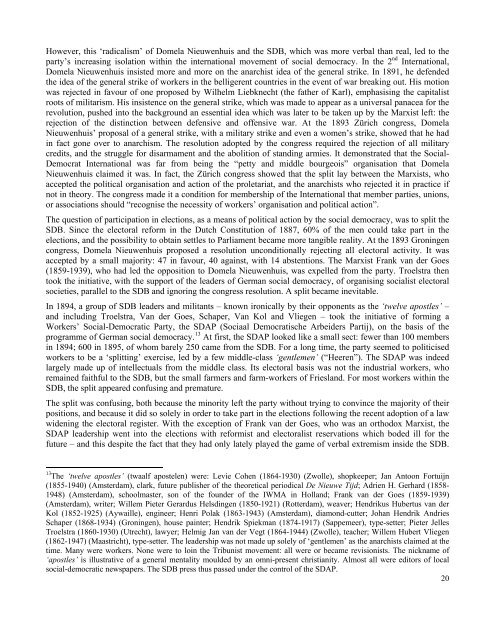The German-Dutch Communist Left - Libcom
The German-Dutch Communist Left - Libcom
The German-Dutch Communist Left - Libcom
You also want an ePaper? Increase the reach of your titles
YUMPU automatically turns print PDFs into web optimized ePapers that Google loves.
However, this ‘radicalism’ of Domela Nieuwenhuis and the SDB, which was more verbal than real, led to the<br />
party’s increasing isolation within the international movement of social democracy. In the 2 nd International,<br />
Domela Nieuwenhuis insisted more and more on the anarchist idea of the general strike. In 1891, he defended<br />
the idea of the general strike of workers in the belligerent countries in the event of war breaking out. His motion<br />
was rejected in favour of one proposed by Wilhelm Liebknecht (the father of Karl), emphasising the capitalist<br />
roots of militarism. His insistence on the general strike, which was made to appear as a universal panacea for the<br />
revolution, pushed into the background an essential idea which was later to be taken up by the Marxist left: the<br />
rejection of the distinction between defensive and offensive war. At the 1893 Zürich congress, Domela<br />
Nieuwenhuis’ proposal of a general strike, with a military strike and even a women’s strike, showed that he had<br />
in fact gone over to anarchism. <strong>The</strong> resolution adopted by the congress required the rejection of all military<br />
credits, and the struggle for disarmament and the abolition of standing armies. It demonstrated that the Social-<br />
Democrat International was far from being the “petty and middle bourgeois” organisation that Domela<br />
Nieuwenhuis claimed it was. In fact, the Zürich congress showed that the split lay between the Marxists, who<br />
accepted the political organisation and action of the proletariat, and the anarchists who rejected it in practice if<br />
not in theory. <strong>The</strong> congress made it a condition for membership of the International that member parties, unions,<br />
or associations should “recognise the necessity of workers’ organisation and political action”.<br />
<strong>The</strong> question of participation in elections, as a means of political action by the social democracy, was to split the<br />
SDB. Since the electoral reform in the <strong>Dutch</strong> Constitution of 1887, 60% of the men could take part in the<br />
elections, and the possibility to obtain settles to Parliament became more tangible reality. At the 1893 Groningen<br />
congress, Domela Nieuwenhuis proposed a resolution unconditionally rejecting all electoral activity. It was<br />
accepted by a small majority: 47 in favour, 40 against, with 14 abstentions. <strong>The</strong> Marxist Frank van der Goes<br />
(1859-1939), who had led the opposition to Domela Nieuwenhuis, was expelled from the party. Troelstra then<br />
took the initiative, with the support of the leaders of <strong>German</strong> social democracy, of organising socialist electoral<br />
societies, parallel to the SDB and ignoring the congress resolution. A split became inevitable.<br />
In 1894, a group of SDB leaders and militants – known ironically by their opponents as the ‘twelve apostles’ –<br />
and including Troelstra, Van der Goes, Schaper, Van Kol and Vliegen – took the initiative of forming a<br />
Workers’ Social-Democratic Party, the SDAP (Sociaal Democratische Arbeiders Partij), on the basis of the<br />
programme of <strong>German</strong> social democracy. 13 At first, the SDAP looked like a small sect: fewer than 100 members<br />
in 1894; 600 in 1895, of whom barely 250 came from the SDB. For a long time, the party seemed to politicised<br />
workers to be a ‘splitting’ exercise, led by a few middle-class ‘gentlemen’ (“Heeren”). <strong>The</strong> SDAP was indeed<br />
largely made up of intellectuals from the middle class. Its electoral basis was not the industrial workers, who<br />
remained faithful to the SDB, but the small farmers and farm-workers of Friesland. For most workers within the<br />
SDB, the split appeared confusing and premature.<br />
<strong>The</strong> split was confusing, both because the minority left the party without trying to convince the majority of their<br />
positions, and because it did so solely in order to take part in the elections following the recent adoption of a law<br />
widening the electoral register. With the exception of Frank van der Goes, who was an orthodox Marxist, the<br />
SDAP leadership went into the elections with reformist and electoralist reservations which boded ill for the<br />
future – and this despite the fact that they had only lately played the game of verbal extremism inside the SDB.<br />
13 <strong>The</strong> ‘twelve apostles’ (twaalf apostelen) were: Levie Cohen (1864-1930) (Zwolle), shopkeeper; Jan Antoon Fortuijn<br />
(1855-1940) (Amsterdam), clark, future publisher of the theoretical periodical De Nieuwe Tijd; Adrien H. Gerhard (1858-<br />
1948) (Amsterdam), schoolmaster, son of the founder of the IWMA in Holland; Frank van der Goes (1859-1939)<br />
(Amsterdam), writer; Willem Pieter Gerardus Helsdingen (1850-1921) (Rotterdam), weaver; Hendrikus Hubertus van der<br />
Kol (1852-1925) (Aywaille), engineer; Henri Polak (1863-1943) (Amsterdam), diamond-cutter; Johan Hendrik Andries<br />
Schaper (1868-1934) (Groningen), house painter; Hendrik Spiekman (1874-1917) (Sappemeer), type-setter; Pieter Jelles<br />
Troelstra (1860-1930) (Utrecht), lawyer; Helmig Jan van der Vegt (1864-1944) (Zwolle), teacher; Willem Hubert Vliegen<br />
(1862-1947) (Maastricht), type-setter. <strong>The</strong> leadership was not made up solely of ‘gentlemen’ as the anarchists claimed at the<br />
time. Many were workers. None were to loin the Tribunist movement: all were or became revisionists. <strong>The</strong> nickname of<br />
‘apostles’ is illustrative of a general mentality moulded by an omni-present christianity. Almost all were editors of local<br />
social-democratic newspapers. <strong>The</strong> SDB press thus passed under the control of the SDAP.<br />
20
















